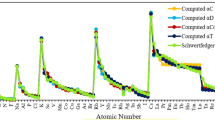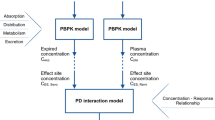Abstract
We have explored the ability of molecular mechanics energy calculation as a probe to obtain quantitative information about the molecular shape and energies of inhalational anesthetics. (Molecular mechanics is a readily accessible, nonquantum mechanical method of computing detailed molecular structure from energetical viewpoint.) From this aspect, the structure-activity relationships of ten inhalational anesthetics were studied. Using this method, stable conformers of these anesthetics are deduced with various physicochemical parameters. The importance of dipole interaction as the major determinant of stable conformation was suggested, and reasonable correlations between anesthetic potency (minimum alveolar concentration: MAC) and components of dipole moments, with reference to the specific sites of molecules, were obtained. The results indicate that there are important polar components which playa major role in anesthesia.
Similar content being viewed by others
References
Overton E: Studien under die Narkose zugleich ein Beitrag zur allgemeinen Pharmakologie. Jena: Verlag von Gustav Fischer. 1901
Meyer H: Welche Eigenschaft der Anaesthetica bedingt ihre narkotische Wirkung? Naunyn-Schmiedebergs Arch. Exp Pathol Pharmakol 42: 109–118, 1899
Targ AG, Yasuda N, Eger EI II, Huang G, Vernice GG, Terrell RC, Koblin DD: Halogenation and anesthetic potency. Anesth Analg 68:599–602, 1989
Halsey MJ: A reassessment of the molecular structure-functional relationships of the inhaled general anesthetics. Br J Anaesth 56:9s-25s, 1984
Osawa E, Musso H: Molecular mechanics calculations in organic chemistry: Examples of the usefulness of this simple nonquantum mechanical model. Angev Chem 22:1–68, 1983
Hellberg S, Wold S, Dunn WJ III, Gasteiger J, Hutchings MG: The anesthetic activity and toxicity of halogenated ethyl methyl ethers, a multivariate QSAR modelled by PLS. Quant Struct-Act Relat 4:1–11, 1985
Loew G, Motulsky H, Trudell J, Cohen E, Hjelmeland L: Quantum chemical studies of the metabolism of the inhalation anesthetics methoxyflurane, enflurane, and isoflurane. Mol Pharmacol 10:406–418, 1974
Ruelle P, Sandorfy C: Electrostatic potential around halogenated anesthetics. Acidic hydrogen; chlorine vs. fluorine. Inter J Quant Chem 21:691–707, 1982
Li YS, Durig JR: Microwave, infrared and Raman spectra, conformational stability and vibrational assignment of methoxyflurane. J Mol Struc 81:181–194, 1982
Di Paolo T, Kier LB, Hall LH: Molecular connectivity and structure-activity relationship of general anesthetics. Mol Pharmacol 13:31–37, 1977
Allinger NL: Conformational analysis. 130. MM2. a hydrocarbon force field utilizing V1 and V2 torsional terms. J Am Chem Soc 99:8127–8134, 1977
Burkert U, Allinger NL: Molecular mechanics. Washington, D.C.: American Chemical Society. 1982
Katoh T, Ikeda K: The minimum alveolar concentration (MAC) of sevoflurane in humans. Anesthesiology 66:301–303, 1987
Sanjo Y, Ikeda K: A small bypass mixing chamber for monitoring metabolic rate and anesthetic uptake: The bymixer. J Clinic Monitor 4:235–243, 1987
Hansch C, Fujita T: ρ-σ-π: Analysis. A method for the correlation by biological activity and chemical structure. J Am Chem Soc 86:1616–1626, 1964
Goldblum A, Loew GH: Quantum chemical studies of anaerobic reductive metabolism of halothane by cytochrome p-450. Chem BioI interactions 32:83–99, 1980
Allinger NL, Chang SHM, Glaser DH, Honig H: An improved molecular mechanics force field for alcohols and ethers. Israel J Chem 20:51–56, 1980
Meyer AY: Molecular mechanics of organic halides. part 6. Modified Del Re electrostatics and the force field. J chem Soc Perkin Trans 2:1199–1204, 1982
Author information
Authors and Affiliations
About this article
Cite this article
Shiraishi, Y., Fujise, Y., Ikeda, K. et al. The relationship between anesthetic potency (minimum alveolar concentration) and molecular shape; Structural studies on conventional inhalational anesthetics. J Anesth 5, 370–379 (1991). https://doi.org/10.1007/s0054010050370
Received:
Accepted:
Issue Date:
DOI: https://doi.org/10.1007/s0054010050370




